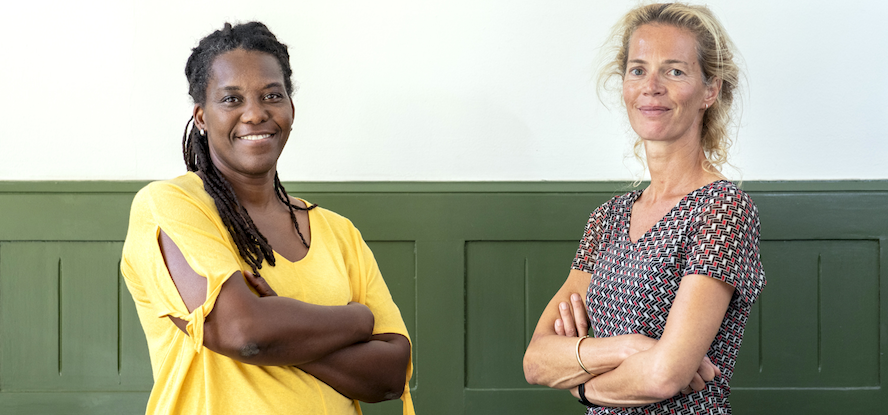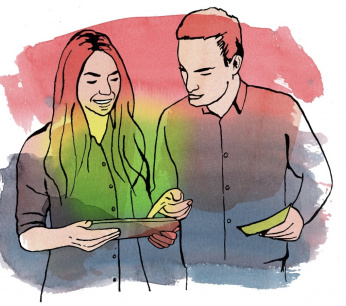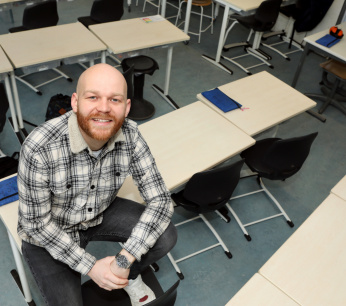Higher education awaits a heated debate on racism
Young people with a migrant background do considerably worse in higher education than their white fellow students. That is not due to these young people, but to the learning environment. "We have to learn to listen to their story, even if it can get pretty unpleasant and uncomfortable."

Picture: Fred van Diem
In June they filled parks and squares in all student cities - from Groningen to Maastricht and from The Hague to Tilburg. Black youths, flanked by their white fellow students, neatly one and a half meters apart. They clenched their fists and chanted - with mouth caps on - Black Lives Matter! Out of solidarity with the blacks who died in the US as a result of police violence, but also to protest against the inequality of opportunities in Dutch education.
These demonstrations came as no surprise to Aminata Cairo, lecturer in inclusive education at The Hague University of Applied Sciences for the past three years. “What comes up now has been going on for years. Students with a migration background have felt excluded and discriminated for much longer. The corona epidemic made them more vulnerable and isolated. Then the long-standing frustration and anger comes out. The Black Lives Matter protests in the US have only been the catalyst. ” And it certainly wasn't a one-time eruption.
“This is only the beginning, we will be hearing a lot from these young people,” says Machteld de Jong, professor of diversity issues at Inholland University of Applied Sciences. “We are dealing with a self-confident generation, young people who are proud of their identity and cannot be put aside anymore. They have the mentality: here I am and I matter. ” As a result, the debate about racism and discrimination is fierce and that is allowed, De Jong believes. “As long as the feelings of the other are taken into account. And that can be done by being open to the stories, perception and experience of your discussion partners. ”
We are dealing with a self-confident generation, young people who are proud of their identity and no longer allow themselves to be pushed aside. They have the mindset: here I am and I matter.
“We have to learn to listen to the other person's story,” says Aminata Cairo, who has been working as an independent consultant since September. "Even though that can get very uncomfortable and uncomfortable." Amfi, the fashion institute of the Amsterdam University of Applied Sciences, has already had a taste of this. In June, a number of (former) students of color went to HvanA, the university's news platform, because they have felt discriminated against and disadvantaged for years. That started when they learned how to search for information in the library in the first week of their training. In the teaching material, the freshmen are encouraged to look for sources as hunter-gatherers. To illustrate this, images are included of black men in loincloths chasing a herd of wildebeest with a bow and arrow. Fearing that complaining will affect the assessment of their papers, many students keep quiet. Complaints about teachers who used the n-word or called Amsterdam-Zuidoost a ghetto where students 'fortunately' did not have to complete an assignment this year, did end up with mentors, counselors or the examination committee, but had little effect. 'Then you receive an email with apologies and promises that something will really change. That feels like damage control', a student tells HvanA.
Clumsy
“I assume that such a hunter-gatherer incident does not immediately stem from racism. It is well-intentioned, but awkwardly presented ”, Machteld de Jong thinks. “But there must be room for an open and honest conversation in which students can express their hurt. Students should regard the university of applied sciences as a safe place where people listen to each other without prejudice. ”
Such an open climate prevails at Hogeschool Inholland, says the professor. "There is an open debate about identity, about who you are, in which students and staff can show their vulnerability." According to her, this is thanks to Jet de Ranitz, who was President of Inholland for the past six years. "She has ensured that diversity policy is in our DNA."
I always start my lessons by asking how my students are doing and I am also open about myself and my experiences. To connect, you have to show something of yourself
This mainly lies in opening up to others, says De Jong, who has been a lecturer since 2018 and also teaches. “As a teacher you have to be approachable to students, have a chat in the hallway, be interested in their background. You need to bond with them. I always start my lessons by asking how my students are doing and I am also open about myself and my experiences. To make a connection, you have to show something of yourself. ” She immediately puts her money where her mouth is: "I was a first-generation student myself and then you better understand what it's like to step into another world."
Discomfort
Aminata Cairo has Surinamese parents, was born in the Netherlands, but left for the US when she was eighteen. “I didn't feel at home here. In my youth there were almost no black Dutch people outside my immediate environment. I only remember a black tram conductor and a black bus driver. Those were really the only ones who looked like me. You hardly see yourself represented and you still are. My brother has never been bothered by that, he has always stayed in the Netherlands. ”
After a career spanning several decades at various American universities, Cairo returned to the Netherlands as an anthropologist with a PhD. At The Hague University of Applied Sciences, she started with the special assignment to do something about the high dropout rate among students with a migration background, boys and intermediate vocational students. A problem that has been a problem in higher professional education for years. “I have started to define that problem differently”, says Cairo, “because it is not the fault of those young people. They attended the same schools and obtained the same diploma as their white fellow students. These are institutional barriers that affect all students, but which first become visible in these groups because they are the most vulnerable. We should not ask ourselves what is wrong with these young people, but what is wrong with the learning environment we offer them. Do they feel at home, supported and represented? Will their story be listened to? And do teachers feel heard and recognized? That is also very important, because how can they listen to students if they themselves are not heard? "
We should not ask ourselves what is wrong with these young people, but what is wrong with the learning environment we offer them. Do they feel at home, supported and represented?
It's an uncomfortable message that provokes resistance. “When you say that we maintain a system that creates inequality of opportunities, teachers quickly feel attacked. After all, they have done their best for years. But we have to ask ourselves whether 'as we have always done here' will still provide an effective learning environment for today's students. ”
Workload
Space is needed to talk about charged topics such as racism and discrimination, says Cairo. “We often don't dare to do that now. There is a lot of fear in higher education. This has to do with the way the staff is treated. For example, administrators are fully committed to internationalization. To attract more students, because other institutions are doing it too. But teachers are not asked how they view English-language education. Teachers therefore do not feel known and appreciated, but do not dare to admit it. The staff knows that if you are found difficult, you can be fired. Especially if you have a temporary contract. ”
The staff know that if you are found to be a nuisance, you can be fired. Especially if you have a temporary contract
De Jong also sees that open and honest conversation is not always conducted. “The big pitfall is work pressure. Time and attention is needed to deal consciously with diversity issues. A teacher must have the space to not only focus on the subject matter. You should also be able to ask students: Who are you, tell us something about yourself. To avoid polarization in tricky conflicts like about hunter-gatherer images, take your time. Taking each other's sensitivities into account is done step by step. ” It is a cultural change that must be strongly stimulated from above, from the Executive Board, says De Jong.
And that starts with telling the honest story, says Cairo. Just like American universities, Dutch universities and universities of applied sciences give a good picture of who they are and what they stand for in their annual reports and on websites. These have become increasingly slick PR stories that do not do justice to the complex reality, says Cairo. “It is time that universities and universities of applied sciences also dared to face their less attractive sides. Stories should be listened to that deviate from the PR story. That takes guts. "
This article appeared in the October issue of the Education Magazine. read more about the trade magazine for education staff.


